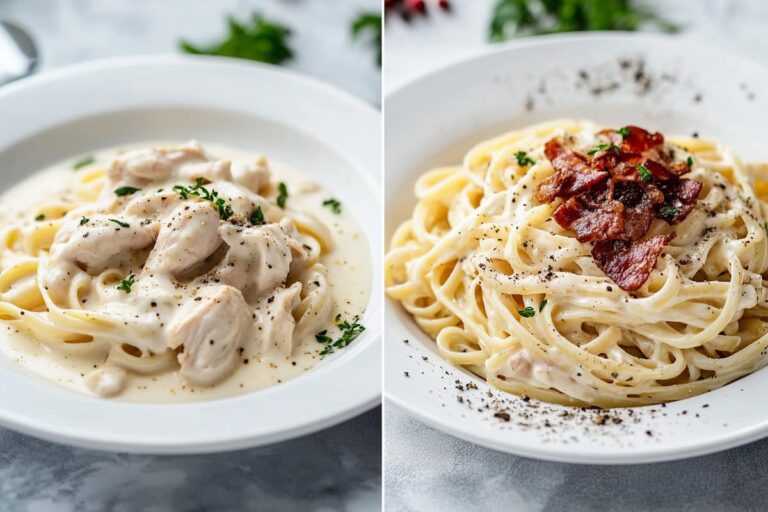There’s an undeniable appeal to Italian cuisine. Its signature sauces, diverse pasta shapes, and the savoury magic they create when combined have garnered international popularity. Two Italian sauces, Alfredo and Carbonara, have mainly won many hearts with their creamy textures and vibrant flavours. But what exactly distinguishes Alfredo from Carbonara in the ongoing debate on Carbonara vs Alfredo?.
Though both sauces are creamy and often used as pasta toppings, their origin, ingredients, preparation methods, flavour profiles, and health considerations differ. This comparative blog delves deeper into these two favourite types of pasta sauces to unravel what makes them both so delightful and distinct.
So, let’s embark on this delectable journey, and while we’re at it, also find answers to some frequently asked questions about Alfredo and Carbonara.
Chicken alfredo and chicken carbonara are two classic pasta dishes that are often confused. While they may seem similar at first glance, with their rich, creamy sauces and chicken ingredients, they are actually quite distinct. This article will break down the key differences between chicken alfredo and chicken carbonara, from origins and ingredients to flavors and preparation methods.
Origins and History
Alfredo di Lelio, an Italian restaurant owner, came up with chicken alfredo in 1914. The story goes that Alfredo made his famous creamy pasta sauce to help his pregnant wife eat. The sauce, which was rich but easy to digest, was a hit, and Alfredo’s restaurant in Rome became known for its signature dish. Many people first tried chicken alfredo in the United States in the 1970s and 1980s.
Chicken carbonara is also from Italy, but its exact roots are less clear. Most stories say it was created in Rome in the middle of the 20th century. The dish was likely influenced by the rich egg and pork dishes of Amatrice and Naples, which are close by. Some think that carbonara was created as a quick and hearty meal for Italians who worked with charcoal, which is called carbonai in Italian. The dish became more well-known after WWII, when eggs were easier to find.
Ingredients
The core ingredients differ distinctly between chicken alfredo and carbonara
Chicken Alfredo
- Fettuccine or linguine pasta
- Butter
- Heavy cream
- Parmigiano-Reggiano cheese
- Salt and pepper
- Sliced grilled or sauteed chicken breast
Chicken Carbonara
- Spaghetti
- Guanciale or pancetta (cured pork)
- Pecorino Romano cheese
- Eggs
- Black pepper
- Sliced sauteed chicken breast
As you can see, alfredo relies on butter, cream, and Parmigiano-Reggiano for its smooth, creamy sauce. Carbonara gets its richness from pecorino Romano cheese and eggs, with no cream involved. The cured pork provides an additional meaty, salty flavor.
So in short, alfredo uses cream as its base while carbonara uses eggs. The cheese, pork, pasta type, and seasoning differ as well.
Flavors
Thanks to the differing ingredients, chicken alfredo and carbonara offer unique flavor experiences:
Alfredo is creamy, rich, and mildly cheesy. The sauce coats each strand of fettuccine in velvety Parmesan creaminess, dotted with salty pops of chicken. Some versions add garlic and herbs for extra complexity. Overall, a simple, comforting flavor.
Carbonara is rich yet light, with sharp cheesiness rounded out by pork fat and pepper. The sauce clings to each spaghetti strand in an eggy, decadent coating, with cured pork adding a hits of savoriness. The pecorino and black pepper pack a punchier flavor than alfredo.
In general, carbonara is stronger, brighter, and more complex, while alfredo is milder and has a more subtle flavor. Adding pork to carbonara also makes it taste better.
Preparation Methods
Preparing chicken alfredo and carbonara requires different techniques:
Alfredo:
- Cook pasta just shy of al dente in salted water.
- Meanwhile, melt butter over medium heat. Whisk in cream and Parmesan, stirring until smooth and slightly thickened. Season with salt and pepper.
- Drain pasta and add to sauce along with grilled or sauteed chicken slices. Toss to coat.
- Serve garnished with more Parmesan cheese.
Carbonara:
- Cook pasta al dente in salted water.
- While pasta cooks, beat eggs with pecorino Romano, black pepper, and a splash of pasta water in a bowl.
- Cook guanciale or pancetta until crispy.
- Drain pasta and immediately add to bacon fat. Toss quickly to coat.
- Remove pan from heat and add egg mixture, stirring vigorously, until a creamy sauce forms.
- Add chicken slices and toss to combine. The heat from the pasta cooks the eggs gently.
- Serve with extra pecorino Romano and black pepper.
The keys differences here are that alfredo simmers a cream sauce on the stovetop, while carbonara relies on the heat of the pasta to gently cook raw eggs into a smooth sauce. The pork fat left in the pan also enriches carbonara.
When to Choose Each Dish
Here are some tips to help you decide whether to get chicken alfredo or carbonara based on their different tastes, ingredients, and ways of being made:
Choose chicken alfredo when you want:
- A mild, comforting cream sauce
- To use up heavy cream
- A rich dish without pork
- A sauce you can make ahead of time
- To please picky eaters
Choose chicken carbonara when you want:
- A lighter yet still luxurious sauce
- A more complex flavor
- To use up eggs
- A sauce made completely stovetop
- A quick weeknight dinner
- A brighter, sharper pasta dish
Both are great choices when you want:
- A classic Italian chicken pasta
- A date night meal
- To use up chicken breast
- An indulgent, protein-packed dinner
At the end of the day, it comes down to personal taste – do you prefer mild creaminess or sharp egginess? Comforting Parmesan or punchy pecorino? Whip up one or both sauces to decide which chicken pasta rein supreme.
The Bottom Line
Chicken alfredo and carbonara share some key traits – they’re both decadent, chicken-studded pasta dishes from Italy. But at their cores, they contain different base ingredients, distinct flavors, and varied preparation methods. Alfredo is built on cream, while carbonara relies on eggs. The cheese, pork, pasta type, and seasoning differ as well. Alfredo simmers a creamy sauce on the stove, while carbonara mixes everything with hot pasta for a quick one-pan meal.
The choice between the two depends on what flavor profile and ingredients you prefer. But no matter which recipe you choose, you can rest assured you’ll end up with a quintessential, delicious Italian chicken pasta. Both are well worth having in your dinner rotation!

What Are The Ingredients and Preparation Style of These Sauces?
Alfredo and Carbonara both have a creamy texture and a white base, but their ingredient lists and cooking methods are very different. Let’s learn more about each sauce, from the main ingredients that go into it to the specific steps that are used to make it.
The Origins of Alfredo and Carbonara
The Alfredo and Carbonara sauces are rooted in Italy’s rich culinary heritage, but their creation stories differ. Let’s briefly look at the history of both sauces.
The origin of Alfredo sauce dates back to 1914. Alfredo di Lelio in Rome prepared this sauce for his pregnant wife, using just butter and Parmesan cheese. His ‘Fettuccine Alfredo’ became a beloved dish beyond Italy after American film stars Mary Pickford and Douglas Fairbanks shared it in the U. S. Following slight adaptations, it gained popularity on American menus. Today, the creamy Alfredo sauce remains a timeless culinary favourite worldwide. According to the founder of Pete’s Protein Pasta, Alfredo’s appeal is its ability to be both a comfort food & a sophisticated dish at the same time, making it a global culinary icon.
The origins of Carbonara sauce are less precise than Alfredo’s. It first appeared in Ippolito Cavalcanti’s 1839 Neapolitan cookbook without a detailed origin backstory. The dish’s name, meaning “coal-worker’s style,” may link it to simple, hearty meals for coal workers or the black pepper flecks resembling coal. Another theory ties it to World War II, when Italians combined powdered eggs and bacon from Allied rations. Despite its mysterious origins, Carbonara has become a beloved classic, cherished by cooks worldwide.
What is the difference between carbonara and alfredo?
FAQ
Is chicken Alfredo the same as carbonara?
What’s the difference between alfredo sauce and carbonara sauce? Alfredo sauce is made with heavy cream, butter, and Parmesan cheese. It’s usually served with fettuccine. Carbonara is made with eggs (and extra yolks), Parmesan cheese, and pancetta or bacon.
Can I use Alfredo sauce for carbonara?
Enjoy a classic Italian dinner with our Fettuccine Carbonara recipe. Mix our tasty Alfredo sauce with soft fettuccine noodles, crispy bacon, and onions that have been sautéed. Serve hot.
What is healthier, carbonara or Alfredo?
What’s healthier, carbonara, or Alfredo? Between the two, the healthier option depends on the preparation. Alfredo sauce is usually made with a lot of butter and cream, while carbonara is usually made with eggs, cheese, and pork. This cauliflower-based carbonara recipe offers a lighter alternative to both.
What does carbonara taste like?
Carbonara has a rich, savory, and creamy taste, with dominant flavors of egg yolk, salty pork (like guanciale or pancetta), and sharp, peppery Pecorino Romano cheese. It’s not overly eggy, despite the presence of eggs, as the yolks blend with the cheese and pasta water to create a silky, luscious sauce.
